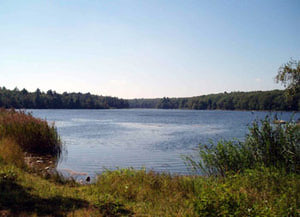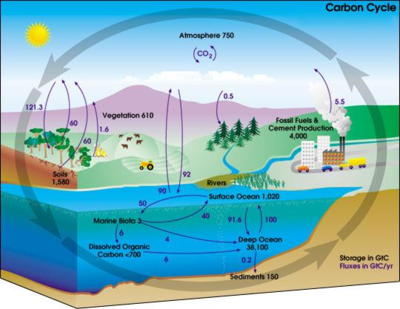Freshwater Lakes
Introduction
Freshwater lakes are bodies of still, unsalted water surrounded by land. They are usually found in low laying areas and are fed from streams, rivers and runoff from the surrounding area. Freshwater lakes provide a unique habitat for microbes because they differ from other aquatic habitats such as oceans and moving water. This habitat is home to a plethora of microbes such as proteobacteria, actinobacteria, cyanobacteria, and bacteroidetes. These microbes help sequester inorganic compounds, mineralize nitrogen, and decompose organic matter, as well as other important processes.
In the introduction, briefly describe the habitat that is the topic of this page. Introduce the habitat, its ecological significance, and the importance of microorganisms in this environment. (What processes do they carry out? What functions do they perform?)
Physical environment
Physical
Freshwater lakes are formed in a variety of different ways and depending on how a lake was formed, it can affect the microbes that are able to live and survive. Common types of lakes are stream or river fed lakes, glacial lakes, which are created by melting glaciers, and artificial lakes, which can be formed by the addition of a dam from old mines or quarries which have filled in after use. Another more unique lake type is a subglacial lake, which is a lake permanently covered by ice such as in Antarctica.
River Fed
These lakes have their input and output from rivers. This differs then from other types of lakes because they can receive storm water run off from not only the surrounding area but from all the areas in the basin of the lake and feeding rivers.
Subglacial
A subglacial lake is one in which there is flowing water under a glacier, ice cap, or ice sheet. They are found is regions such as Antarctica which are constantly under the freezing point. Only certain types of unique bacteria are able to thrive in such environments. This is also the only type of lake which is known to exist in an extraterrestrial location. Jupiter’s moon Europa’s surface is entirely covered in an ice sheet, and it is believed to be one of the most likely locations for extraterrestrial life.
Artificial
These include lakes formed from dams,man-dug, or mines and quarries.
Dammed
Dammed lakes are fed by rainwater and inflow of a river, and drain from outflow from drains on the dam. Water quality testing is done often in this type of lake to insure the dam or other inputs are not polluting the water.
Man Dug
These lakes only receive water run off from the surrounding areas and precipitation. Lakes such as these are often built near roadways and other urban areas and have a higher about of pollutants than more natural lakes.
Mines/Quarries
Old and abandoned mines and quarries often become lakes because most require the use of water control devices to keep ground water from seeping in. Lakes formed this way often have high amounts of contamination due to chemicals and machinery used in the harvesting process.
Chemical
Many factors contribute to the chemical environment in which lake microbes live. These include the drainage basin, the amount of water flowing in and out of a lake, the concentrations of nutrients and dissolved oxygen, the pH, and any pollutants and sedimentation in a lake. The overall drainage basin will affect the amount of run off from other sources in the surrounding area, which will, in turn, affect the amount of nutrients available to microbes and will increase pollutants and sedimentation. The lake level, which is regulated by inflow and outflow of a lake, the pH and the dissolved oxygen content in a lake, will also determine what types of microbes can survive because each microbe has its own unique environmental conditions in which it can outcompete the competition.
Microbial communities
The microbial community in freshwater lakes is as diverse as any other ecosystem found on earth. These microbes have found a way to take advantage of the different resources provided from lake habitats oppose to terrestrial soil habitats microbes are usually thought to live. The main players are proteobacteria, cyanobacteria, actinobacteria, and bacteroidestes. All of these different microbes contribute to important processes carried out in freshwater lakes.
Proteobacteria
This is the most abundant and commonly found group of microbes in freshwater lakes. Proteobacteria is broken up into alpha-, beta-, delta-, and gammaproteobacteria, each with their own distinct characteristics.
Alpha/Gamma
Alpha and gamma are mostly commonly found in marine habitats, but still can be found in freshwater water columns. They tend to be phototrophic and contribute to increasing the amount of dissolved oxygen in a lake.
Beta
Beta are most common of the proteobacteria in lakes. They consist of phototrophs, in some places makes up 60% of the bacterioplankton, and chemolithotrophes. They also play an important role in nitrogen fixation and oxidation of ammonium.
Delta
Delta tend to live in anaerobic conditions such as the bottom of lakes or in sediment and they commonly reduce sulfur as a source of energy.
Cyanobacteria
Cyanobacteria are other bacteria which preforms photosynthesis. They tend to be the dominant bacterial phototrophs in open parts of a lake and are important in the carbon cycle, but also the nitrogen cycle because some are capable of nitrogen fixation.
Actinobacteria
This microbe can be found in a wide range of water chemistries. They are decomposers of organic matter and tend to favor conditions with low concentrations of organic carbon because they can be outcompeted when carbon concentration rise.
Bacteroidetes
This microbe is a commonly particle associated in bacterial communities. They are found at the bottom of lakes where they can degrade larger molecules.
Microbial processes
The two main microbial processes that occur in freshwater lake habitats are the nitrogen and carbon cycle. Both these cycles affect the lives of the macro flora and fauna which share this habitat.
Carbon cycle
The carbon cycle allows carbon to be recycled and reused throughout the biospheres and all living organisms. It is essential for new life. While this diagram shows the carbon cycle in marine habitats, the same is true in freshwater lakes but at a much smaller scale.
Nitrogen cycle
Here is a diagram of the nitrogen cycle. The Nitrogen cycle is the process in which nitrogen is converted into different forms. The majority of nitrogen is found in the atmosphere where it is unusable by plants, but through the processes of microbes, as well as other processes, it can be converted into a form plants can consume. It is important to note that Nitrospira, and Nitrosomonas are types of betaproteobacteria.
Other processes
Another important process that is carried out in freshwater habitats is decomposition. Decomposition is the breaking down of organic matter into simpler forms. This is preformed by different types of microbes such as actinobacteria and results in the reduction of dead organic matter in the lake, and increased food sources for living flora and fauna. Without decomposition, lakes would be clouded with a layer of dead organic matter and there would be very little sunlight penetration for photosynthesis.
Current Research
Koschorreck et al.
In a study done in 2011 by Koschorreck et al., They looked at how adding whey to an acidic mine pit lake could induce oxygen depletion. They added whey into the water column or the lake and mixed it using a boat motor. By doing this they found it helped neutralize the acidity of the pit and allowed oxygen consumption. Even though a small amount of oxygen was produced by primary producers, this still led to anoxic conditions.
Verleyen et al.
This study done in 2012 looked at polar lakes and how they responded to climate induced environmental changes. They looked at differences in pH, and concentrations of major nutrients between lakes. They found the variability could have been caused by lake origin and evolution, catchment areas, distance of lakes to ice sheets and presence of particular biota.
Esteban et al
This study done in 2012 looked at water columns of Priest Pot. It is a highly stratified lake and they found that dissolved oxygen content at changing depths was the main factor that determined which microbes lived where because different microbes could find niches. They also looked at biological activity driven my microbes, and looked at the different species present throughout the water column and sediments.
References
Edited by <your name>, a student of Angela Kent at the University of Illinois at Urbana-Champaign.



